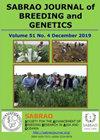哈萨克斯坦矿质肥料在农业中的应用现状与展望
IF 1.7
Q3 PLANT SCIENCES
引用次数: 3
摘要
这篇文章专门分析了全球矿物肥料的生产和使用情况,重点是哈萨克斯坦的农业。1950年至2020年,哈萨克斯坦耕地氮磷钾用量为每公顷3.6-29.0 kg。1986年哈萨克斯坦的肥料效益达到最大,在占总耕地47%的土地上施用了1039吨矿物肥料(活性物质),而在1965年,施肥面积仅占整个播种面积的6.6%。在哈萨克斯坦,矿物肥料的年推荐需求量为100万吨(有效成分)。讨论了长期施用化肥对土壤肥力和作物生产力主要指标的影响。通过回归分析还发现了化肥使用强度、土壤农化指标、作物产量及其质量四个可行因素之间存在高度正相关的概率。本文章由计算机程序翻译,如有差异,请以英文原文为准。
STATE AND PROSPECTS OF MINERAL FERTILIZERS USE IN AGRICULTURE OF KAZAKHSTAN
The article is a dedicated analysis of the production and use of mineral fertilizers globally, focusing on the agriculture of Kazakhstan. From 1950 to 2020, the fertilizer use ranged between 3.6–29.0 kg of NPK per hectare in arable agricultural land of Kazakhstan. The maximum benefit of fertilizers happened in 1986 in Kazakhstan, with 1,039 t of mineral fertilizers (active substances) applied at an area of 47% of the total arable land, while in 1965, the fertilized area was only 6.6% of the entire sown field. In Kazakhstan, the annual recommended need for mineral fertilizers is one million tons (active ingredient). The paper also discussed the influence of the long-term application of fertilizers on the leading indicators of soil fertility and crop productivity. Employing regression analysis also explored a high degree of probability of a positive relationship among the four viable factors, i.e., fertilizer use intensity, agrochemical indicators of the soil, crop plants yields, and their quality.
求助全文
通过发布文献求助,成功后即可免费获取论文全文。
去求助
来源期刊

Sabrao Journal of Breeding and Genetics
农林科学-奶制品与动物科学
CiteScore
1.90
自引率
50.00%
发文量
63
期刊介绍:
The SABRAO Journal of Breeding and Genetics is an international journal of plant breeding and genetics research and was first published in 1969. It is the official publication of the Society for the Advancement of Breeding Research in Asia and Oceania (SABRAO).
Its objectives are to: promote the international exchange of research information on plant breeding and genetics, by describing new research findings, or ideas of a basic or practical nature; and be a medium for the exchange of ideas and news regarding members of the Society.
The Journal gives priority to articles that are of direct relevance to plant breeders and with emphasis on the Asian region. Invited for publication are research articles, short communications, methods, reviews, commentaries, and opinion articles. Scientific contributions are refereed and edited to international standards.
The journal publishes articles for SABRAO members mainly. The Journal preferred strongly that at least one author should be a current member of the Society. Non-members may also publish in the journal.
 求助内容:
求助内容: 应助结果提醒方式:
应助结果提醒方式:


